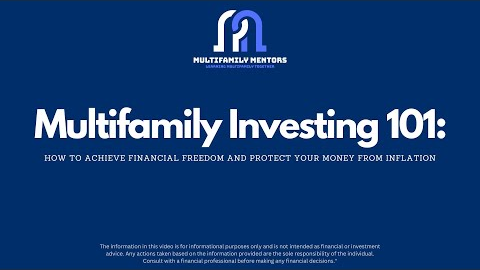Multifamily Investing 101 How to Achieve Financial Freedom and Protect Your Money from Inflation
9 View
Share this Video
- Publish Date:
- January 30, 2023
- Category:
- Appreciation Investing
- Video License
- Standard License
- Imported From:
- Youtube
Tags

When it comes to investing, there are countless options to choose from.
Stocks, bonds, mutual funds, and more.
But one investment that stands out among the rest is multifamily real estate.
One of the biggest benefits of investing in multifamily properties is the potential for steady cash flow.
Unlike stocks or bonds that rely on market conditions, rental income from multifamily properties can provide a consistent return on investment.
Cash flow is the key to financial freedom because it allows you to have a consistent source of income that can be used to cover your expenses, invest in other opportunities, and save for the future.
When you have a positive cash flow, you have more money coming in than going out.
This can help you to pay off debt, build an emergency fund, and invest in assets that will appreciate in value over time.
Having a positive cash flow also allows you to have more flexibility and control over your finances, which is essential for achieving financial freedom.
Another advantage of multifamily investing is the ability to leverage economies of scale.
By purchasing a larger property with multiple units, you can spread the costs of property management, maintenance, and other expenses over more units, potentially increasing your return on investment.
Additionally, buying a 10 unit property is as much effort as buying a single-family home, helps the accumulation of cash-flowing rentals grow exponentially.
Additionally, multifamily properties can also provide tax benefits.
They offer deductions for depreciation, mortgage interest, and other expenses, which can significantly reduce your tax liability.
Finally, multifamily properties can provide a hedge against inflation.
Multifamily property can hedge against inflation in several ways:
As the cost of living increases, so do rental rates, which can help to keep pace with inflation and protect your investment over time.
Rent increases: As the cost of living increases, so do rental rates.
This means that as inflation goes up, the income generated from a multifamily property may also increase, which can help to keep pace with inflation and protect the value of your investment over time.
Operating costs: Inflation can also increase the cost of operating a multifamily property, such as property taxes, insurance, and utilities.
However, many landlords are able to pass these increased costs on to tenants in the form of higher rents, which can help to offset the impact of inflation on the property's operating costs.
Appreciation: Multifamily properties, like other real estate, tend to appreciate in value over time.
As inflation increases, the value of the property may also increase, providing a hedge against the declining purchasing power of the dollar.
Tax benefits: Depreciation is a tax benefit that allows landlords to write off a portion of their property's value each year, which can help to reduce their overall tax liability.
As inflation increases, the value of the property may also increase, providing a hedge against the declining purchasing power of the dollar.
It's important to note that no investment is completely immune to inflation, and multifamily properties, like any other asset, can be affected by market conditions.
But owning a multifamily property can provide a hedge against inflation, which can be a valuable aspect of a diversified investment portfolio.
Overall, multifamily real estate investing offers a unique combination of benefits, including steady cash flow, economies of scale, tax benefits, and inflation protection.
It is a solid investment choice for those looking for long-term growth and income potential
------
This information is for informational purposes only and is not intended as financial or investment advice. Any actions taken based on the information provided are the sole responsibility of the individual. Consult with a financial professional before making any financial decisions.
-----














